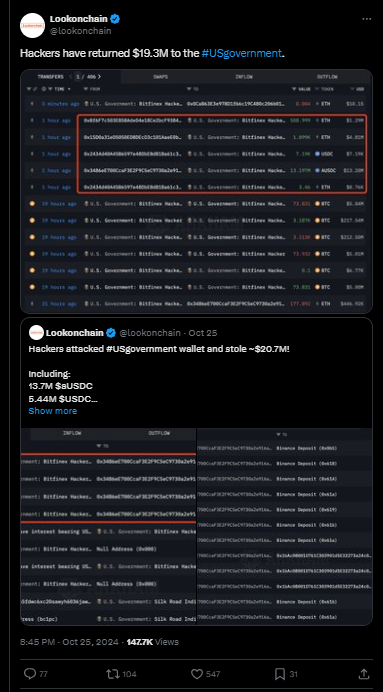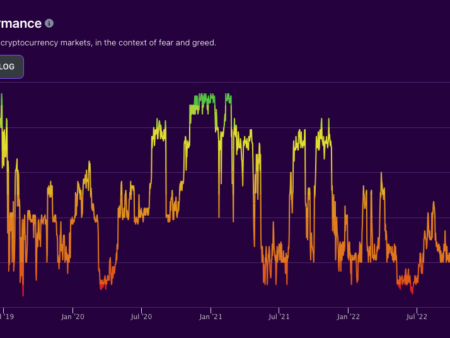Hackers Return $19.2 Million Stolen from U.S. Government-Linked Wallet Amid Ongoing Crypto Thefts
In a surprising turn of events, hackers returned approximately $19.2 million in stolen cryptocurrency to a U.S. government-affiliated wallet, following a sophisticated series of laundering moves through multiple exchanges. This unexpected return of funds comes amidst heightened warnings from the FBI concerning North Korean hacking groups who have been increasingly targeting crypto firms using advanced social engineering techniques.
High-Profile Crypto Heist Stirs Industry on October 24, 2024
On October 24, 2024, the crypto industry was shaken when nearly $20 million in digital assets was pilfered from wallets connected to U.S. government sources. Blockchain analysts traced the theft to transactions initiated by a wallet linked to the infamous 2016 Bitfinex hack, sparking further intrigue and concern. Among the assets siphoned off by the hackers were Ethereum (ETH), USD Coin (USDC), Tether (USDT), and aUSDC tokens.
The stolen funds were moved strategically across platforms, with hackers first draining $1.25 million in USDT and $5.5 million in USDC from the Aave DeFi protocol. Additional transactions were later routed to a separate wallet containing a total of $13.7 million in USDC and $446,000 in ETH, all aimed at muddying the trail and complicating tracking efforts. To further evade detection, the hackers distributed the stolen funds across a web of exchanges and smaller wallet accounts, including Switchain, HitBTC, and N Exchange.

hacker
Hacker’s Unexpected Decision Raises Questions
Surprisingly, blockchain sleuth ZachXBT discovered that the hacker had returned $19.2 million to the initial U.S. government-linked wallet. This unusual decision has left many speculating about the hacker’s motivations, with some suggesting possible reasons such as a fear of detection, ethical reconsiderations, or even accidental wallet use, though the exact rationale remains unclear.
This high-stakes heist and unexpected fund return highlights growing vulnerabilities even in wallets affiliated with government entities. Although much of the stolen assets have been reclaimed, some funds remain unaccounted for, underscoring the ongoing risks and complexities in the crypto space.
A Rising Threat: North Korean Hackers Targeting Crypto Firms
Simultaneously, concerns around state-sponsored hacking have intensified. The FBI has recently issued alerts highlighting the evolving strategies of North Korean hackers targeting major cryptocurrency firms, specifically mentioning attempts to breach Bitcoin ETF issuers. As hacking techniques grow more refined, North Korean groups have reportedly used social engineering attacks, often targeting employees through fraudulent job offers or misleading social media interactions to compromise internal systems.
According to CNF, the FBI’s warnings reflect the rising risks faced by both private and government-affiliated crypto entities in an increasingly hostile cybersecurity environment. Recent cases have shown that no entity is immune, and while most firms are reinforcing their security measures, these persistent threats underline the necessity for continuous adaptation to protect digital assets from cybercriminals and nation-state actors alike.
Government and Industry Responses to the Crypto Threat Landscape
In response to these rising threats, both the U.S. government and the private sector are ramping up efforts to secure crypto assets. Federal agencies are collaborating with crypto companies and blockchain analysts to identify and dismantle cybercriminal networks, with a particular focus on strengthening defenses against state-sponsored hacking groups.
Crypto firms are also increasing their investment in cybersecurity, implementing advanced protocols like multi-signature wallets, intrusion detection systems, and continuous blockchain monitoring. Industry players argue that more robust regulation and enhanced security measures are essential for protecting assets, preventing future breaches, and instilling investor confidence.
Conclusion: A Complex Future for Crypto Security
The October 24 heist and subsequent events underscore the high stakes of cybersecurity in the cryptocurrency industry. As DeFi platforms and crypto exchanges gain popularity, they also become prime targets for cybercriminals. The evolving threat from state-sponsored actors, particularly those backed by North Korea, adds another layer of complexity for firms and governments alike.
Despite the partial recovery of funds, the incident serves as a stark reminder that vulnerabilities remain. Enhanced collaboration between governments, security firms, and crypto companies is increasingly essential for tackling these sophisticated threats. This unprecedented return of stolen assets raises important questions about hacker motives and the effectiveness of security measures, signaling that the crypto industry’s security landscape will need continual adaptation to stay ahead of emerging risk.




















